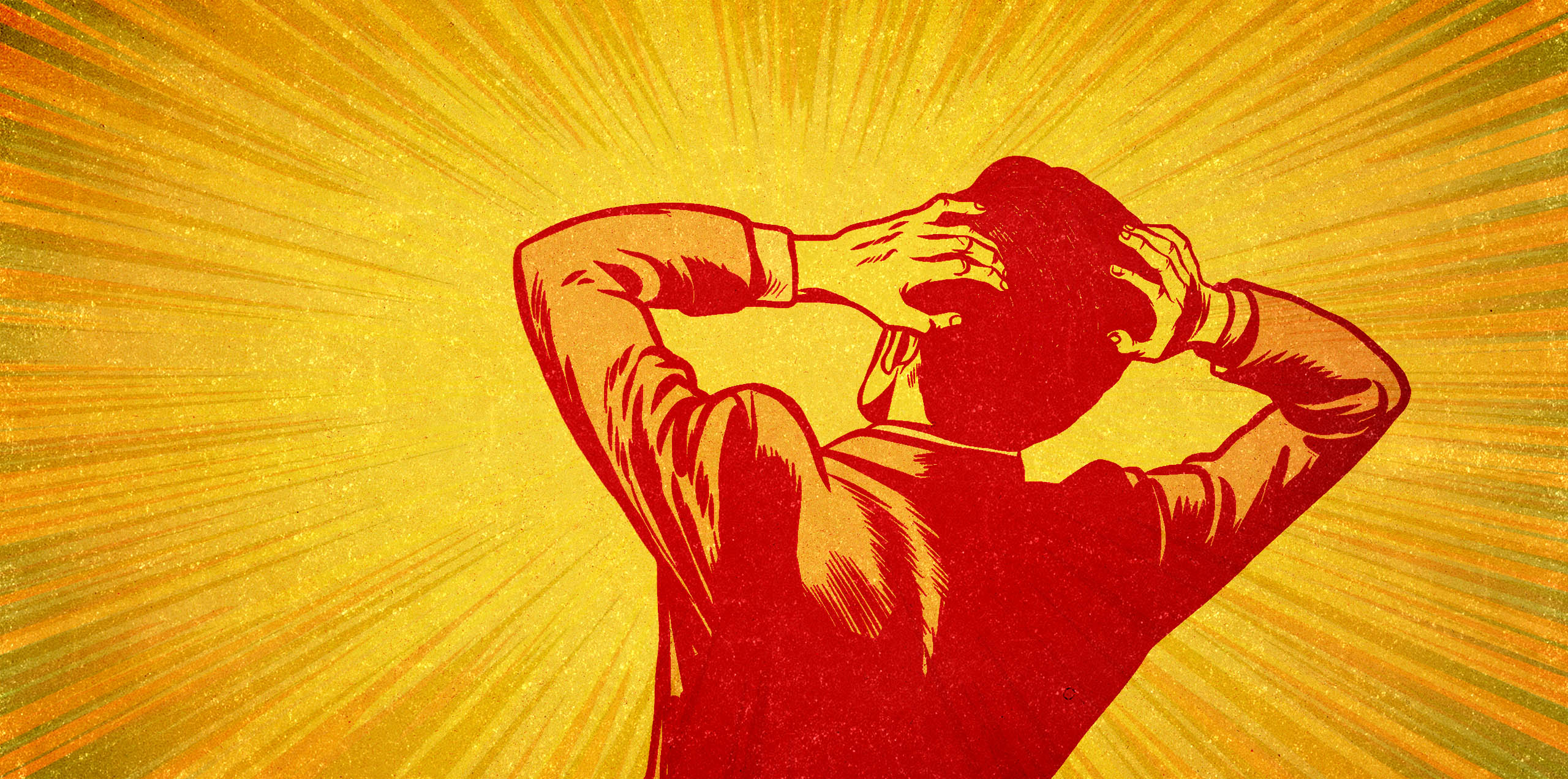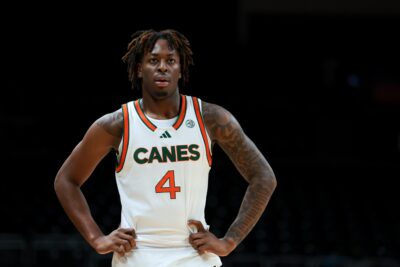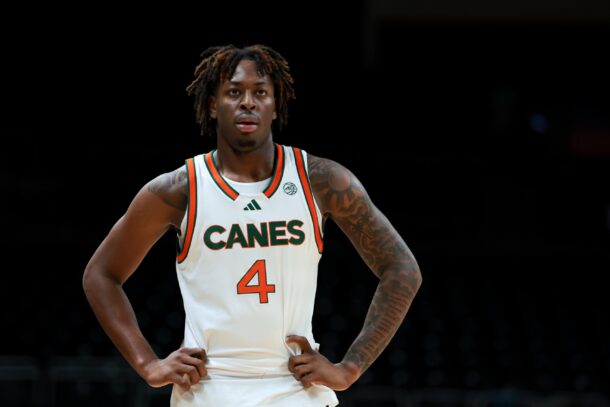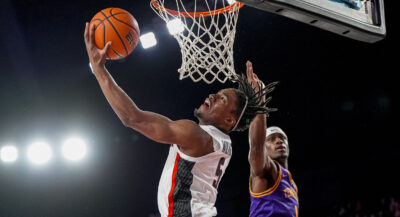
You wanted to be in the ACC, Cal.
Congratulations. You got it.
In the span of just 1 epically long day, you and your newly reenergized fan base got the full ACC experience Saturday.
And it was both glorious and heart-wrenching.
The exhilaration of College GameDay and Marshawn Lynch coming to campus and a kid in checkered Vans kicking a field goal for 100 large?
Check.
The anticipation of a historic victory and the wild celebration that followed?
Check.
A head-scratching call – or in this case, non-call – accompanied by the feeling of angst that goes along with the belief that your team got hosed?
Bingo has been called.
While all that is true, it’s also a fact that the Bears were active participants in their own demise against No. 6 Miami. The specifics of their collapse against No. 6 Miami and the Hurricanes’ 2nd miraculous escape in as many weeks are just 2 of the 10 things I’m absolutely overreacting to after Week 6 in and around Cal’s new conference.
10. A long day’s journey into night … too long
The concept of ACC After Dark sounds great in theory. But in practice, it makes for a long day of football. Especially when it starts 3 hours before the kickoff of the first game of the day with College GameDay at a conference site, as it did Saturday.
Starting with the 4 early window games that started at noon ET through the final play of the Cal-Miami game in Berkeley early Sunday morning, the ACC had at least 1 game going on for a solid 14 straight hours.
I’ll admit, the football fest was fun. But only as a 1-off. Even though there are 2 West Coast members now among the ranks, ESPN needs to remember that the ACC is still the Atlantic Coast Conference. So how about let’s not make these late-night starts a regular thing? OK?
9. Shotgunning themselves in the foot
Somebody please explain to me like I’m a 5th grader why coaches insist on lining up in the shotgun when going for it on 4th-and-short yardage?
Doing so burned 2 ACC coaches Saturday.
One of them twice.
In Chapel Hill, Mack Brown’s North Carolina Tar Heels wasted a 19-play drive that ate up 9 minutes off the clock against Pitt when Jacolby Criswell threw incomplete to running back Omarion Hampton on 4th down and less than a yard to go.
Then in the 4th quarter, with his team trailing by a touchdown, Brown did it again. This time it was a running play to Hampton, who was stuffed at the line on another 4th-and-1 situation from the Panthers’ 8.
4th and less than a yard, and @UNCFootball lined up in the shotgun.
What a moronic decision.
— Tar Heel (@UNCisFamily) October 5, 2024
Later in the evening in Atlanta, Duke found itself in its own 4th-and-1 situation from inside the Georgia Tech 10 with a chance to take its first lead. But instead of having his 6-6 quarterback Maalik Murphy line up under center where he can lean forward for the 1st down, Manny Diaz had him in the shotgun. With a similarly bad result.
It makes absolutely no sense to try and gain 1 or 2 yards to extend a drive or score a touchdown by lining your quarterback up 5 yards behind the line of scrimmage. And yet they all do it.
8. College football’s favorite feeder program
Wake Forest’s Dave Clawson built one of the ACC’s most consistent programs during the 7 seasons from 2016-2022. He did it with a developmental philosophy that relied heavily on player retention and the continuity that comes with it.
He still believes in those things. The only difference is that these days, a lot of the talent they develop doesn’t stay long enough to keep the Deacons on the winning track.
It’s no coincidence that Saturday’s win at NC State notwithstanding, Wake’s fortunes have fallen off considerably since the rule change that allows college athletes to profit from their name, image and likeness. It’s almost as if the Deacons have become a farm system for bigger, richer programs with a higher profile.
Just this year, they lost cornerback DaShawn Jones to Alabama, running back Justice Ellison to Indiana and receivers Jahmal Banks to Nebraska, Ke’Shawn Williams to Indiana and Wesley Grimes to rival NC State. A season earlier, they delivered quarterback Sam Hartman to Notre Dame, cornerback Gavin Holmes to Texas and edge rusher Rondell Bothroyd to Oklahoma. You could only imagine how much better this year’s team would be with that kind of talent on the roster.
Depth is always going to be an issue at the smallest school in the FBS. It’s an obstacle that’s making Clawson’s job even more difficult in the current environment.
7. When in doubt, (don’t) punt … especially if you’re Syracuse
UNC coach Mack Brown had such little faith in his defense that he made the conscious decision to avoid kicking the ball to Pitt whenever possible. His Tar Heels ended up going for it on 4th down 6 times. Including the 2 noted earlier.
It’s an approach Syracuse’s Fran Brown should consider copying starting with this week’s game at NC State. But for the opposite reason.
As unreliable as UNC’s defense is, Brown’s kicking game is even worse. Much worse. The Orange came into Friday night’s game at UNLV having converted only 3-of-7 field goals while ranking dead among FBS programs with 3 blocked kicks allowed (2 field goals and a punt). And they added to the total against the Rebels.
Punter Jack Stonehouse had 1 punt blocked for a touchdown and another that would have been blocked had he not attempted to run for his life. He was stopped short of the 1st down for a turnover UNLV quickly turned into another touchdown. Syracuse still won 44-41 in overtime. But if never would have been that close without the 14 points the Orange gifted the Rebels.
Brown might want to spend a little extra time working on kick protection this week at practice. Either that or find a new special teams coach.
6. A hand injury that forced Mike Norvell’s hand
DJ Uiagalelei’s throwing hand is in a cast. So much for the notion that his medical condition was a subtle ploy for Norvell to bench the struggling quarterback for the game against his former team without actually benching him.
The injury did spare DJU the indignity of getting outplayed by Cade Klubnik, the quarterback who replaced him at Clemson, and enduring further booing from his home crowd at Florida State. But its greatest impact is that it forced Norvell to look to the future by putting redshirt freshman Brock Glenn under center rather than wasting any more time trying to salvage something from an already lost season.
Glenn didn’t put up impressive numbers. He completed 23-of-41 passes for 228 yards and 2 touchdowns, with an interception in the Seminoles’ 29-13 loss. But he gained confidence after a shaky start and looked much more poised – and competent – than in his 2 previous starts at the end of last season.
The opportunity to play meaningful snaps over the 2nd half of the season will allow Glenn to grow and improve while at the same time giving Norvell more of a chance to determine how he fits into FSU’s plans moving forward.
5. What exactly is “targeting?”
The letter of the law is cut-and-dried. Enforcement of the NCAA’s targeting rule, however, is incredibly arbitrary. You can never be certain from one game to the next what’s legal and what isn’t. Let’s just say there’s a lot of gray area involved anytime a player gets his gray matter jogged by a head-to-head hit.
According to the NCAA’s definition, targeting is” any hit that goes beyond the legal tackle or legal block or playing the ball,” specifically when it involves making “forcible contact against an opponent with the crown of his helmet.” In other words, exactly what Miami’s Wesley Bissainthe did to Cal quarterback Fernando Mendoza in the final minutes Saturday.
https://twitter.com/deviousduck_/status/1842810119404581355
Bissainthe didn’t intentionally attempt to injure Mendoza. He was trying desperately to stop an opponent from getting a 1st down that would have denied his team an opportunity to get the ball back and win the game. But in the process, he lowered his shoulders, led with his head and initiated forcible helmet-to-helmet contact, visibly snapping Mendoza’s head back.
Textbook targeting. Right?
Not so fast, my friend.
Upon further review, it was ruled that the hit was not targeting. And the rest, as they say, is history.
The decision, which came from the ACC’s command center not the officials on the field, sparked immediate overreaction from conspiracy theorists convinced the fix was in to keep Miami undefeated.
Sunday musing: How many more makeup calls will Miami get before we declare the debt paid on the bogus PI flag that cost the Canes the 2002 natty?
Gotta be getting close, right? Or will it just continue in perpetuity until the Canes win another natty?https://t.co/Ik44GurZxF— Saturday Down South (@SatDownSouth) October 6, 2024
And there is some reason for suspicion because of the way the Hurricanes’ previous game against Virginia Tech ended. The more likely explanation is that interpretation of the targeting rule is incredibly inconsistent. Just ask NC State’s Grayson McCall, who nearly had his head removed by a helmet-to-helmet hit against Wake Forest that caused him to be carted off on a backboard Saturday. On a play that wasn’t even reviewed.
4. Time to McCall it a season
NC State’s Dave Doeren’s decision to bring McCall back for Saturday’s game was immediately questioned, even as the injured quarterback was still lying motionless on the field from the massive, helmet-ejecting hit he took from Wake Forest linebacker Quincy Bryant.
McCall has already suffered 1 confirmed concussion while at Coastal Carolina last season. And it’s believed he absorbed another earlier this season against Louisiana Tech, forcing him to miss the next 2 games. To be clear, Doeren would never allow a player onto the field unless he was fully cleared my the Wolfpack’s medical staff. He cares too much about the welfare of his players to even think about that.
https://twitter.com/CFBKings/status/1842609039307334112
Because of that concern, Doereen and the doctors need to shut McCall down at least for the rest of the season. Even though the severity of Saturday’s injury has yet to be reported other than that he was released from the hospital and is doing well, a 4th significant blow to the head within a 12-14 month span could potentially be catastrophic.
McCall has seen action in only 4 games this season, so a medical redshirt would likely be on the table if he decided to continue to play and return next season. Either to State or somewhere else. Bringing him back again Saturday might not have been too soon. But allowing him to play again this season might be.
3. How to lose the Heisman, then win it again, all in the same game
Cam Ward started Saturday’s game as the favorite to win the Heisman Trophy. He finished the game the same way.
In between?
Let’s just say that the Miami quarterback could have used a GPS to navigate all the unexpected detours his journey to the Downtown Athletic Club in New York took during the first 2 1/2 quarters in Berkeley. He held onto the ball too long and took sacks, overthrew open receivers on deep balls and made bad decisions – including one that turned into a pick-6 and helped Cal build a 35-10 lead midway through the 3rd period.
But just as his name was about to be deleted from the invitation list for the Heisman ceremony, Ward produced a few more highlights to be shown at the event. Just as he did the previous week in leading the Hurricanes from behind against Virginia Tech.
This time he completed 23 of his final 34 passes for 382 yards and 2 touchdowns while also running for a score. He led his team on drives of 75, 75, 70 and 92 yards, with the latter coming in the game’s final 2 minutes, to produce the 2nd-biggest comeback in school history.
Ward has the arm talent and confidence to make all the throws. But it’s his flair for the dramatic that has helped Miami stay on course for an ACC championship and keep him out front in the race for the Heisman.
2. If not Miami and Clemson, then who?
The Hurricanes are a ticking time bomb just waiting to implode (if the ACC lets them). The Tigers, who have risen back into the top 10, looked either disinterested or vulnerable on the way to disposing of the smoldering dumpster fire that is Florida State.
They’re still the heavy favorites to meet for the conference championship in Charlotte on Dec. 7 (Clemson is at +140 and Miami at +150, according to DraftKings sportsbook). And even if one or both do falter, the list of realistic contenders has already been narrowed down to a precious few.
1, SMU. 2. Pitt. 3. Virginia Tech. 4. Louisville.
There’s a good chance the battle to become the best will be decided in Dallas on Nov. 2 when the Mustangs take on the Panthers.
Exactly as we expected when the season began.
1. No wonder Greg Sankey wants all those automatic bids
The SEC and Big Ten will reportedly meet this week in Nashville to discuss a power grab designed to guarantee each league 4 automatic bids into future College Football Playoffs.
My initial reaction to the news was: Why? If the most powerful of the power conferences are as dominant as they think and say they are, they shouldn’t need automatic bids to get more teams than everyone else into a 12- or 14-team bracket.
Then Saturday happened. And now we know the reason why.
The SEC is going to need them.
Vanderbilt? Really? The Commodores have been the dregs of college football for as long as anyone can remember. And Alabama, the SEC’s best team, couldn’t beat them? Tennessee losing to Arkansas was nearly as bad.
Inevitably, Paul Finebaum and the SEC’s other mouthpieces will spin those embarrassments as “good losses” and proof of the league’s depth and competitiveness. In other words, exactly the opposite of how Virginia Tech’s opening week loss to Vandy was interpreted.
If “good losses” are the criteria for earning an excessive number of automatic bids, then maybe the ACC should get 4, too.
That’s how it works. Isn’t it?
Award-winning columnist Brett Friedlander has covered the ACC and college basketball since the 1980s.






